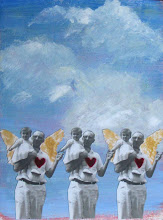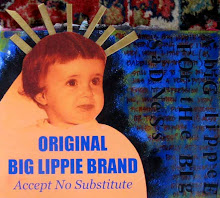
About seven or eight years ago, my husband gave me as a gift a book that was equally both charming and heartbreak-ing at the same time. Called Consider Poor I, it was about the life and works of a woman named Nancy Luce, who lived in the nineteenth century. She lived on Martha's Vineyard and self-published books of her own poetry and stories, mostly about her precious chickens, all hand written and colored and beautifully primitive. In her day she was mocked and abused by those who knew her (and by strangers who thought they knew her), but her work stands today, nearly two hundred years since her birth, as a noble and incredibly heartfelt body of work. And it was because of this beautiful little book, that I decided to make my own chicken book, but with the benefit of modern art tools (and the ever trusty photoshop), rather than just pen and paper. As the years have passed, that one book has morphed into multiple volumes that also include my ducks, and still I continue to make them as my own birds live their lives and pass on.
I've included in my books many of the same elements that Nancy Luce did in hers: photographs of my birds (her tintypes taken at her home must have cost her a small fortune in her day), stories I have written about them, remembrances of special days, anecdotes, and the often-times compulsive habit of "collecting" hen names for future use and listing them throughout each of the books (this can get out of hand as the names begin to number well into the hundreds. Nancy's names were quite odd). And while she would in her writing detail the sorrowful deaths of her beloved birds, I am not so inclined to do go so far as to dwell quite so intently on the morbid, although I do acknowledge the passing of my little friends when it happens.
The books make for a charming little outlet that combines my love of birds with my love of art. It also makes for a nice break (as do my art journals) from the more serious work of painting. Like my journals, the chicken books are an endeavor that is almost childlike in its simplicity. What could be more fun than colored pens, fancy papers and glue sticks? It also touches a place in my heart as I work, a place that makes me think of Nancy Luce and all the other women like her who were so grossly misunderstood in their time, who had they been born far into the future would have been lauded for their originality, for their abilities, and for their enormous heart and soul, rather than be beaten and attacked for their uniqueness in an era when woman were to keep quiet and disappear into the background behind their men and children and never venture into uncharted territory.
Long after I had begun my own modern versions of Nancy Luce's chicken books, I took a trip over to the Vineyard and while there, decided to pay a visit to her grave in one of the local cemeteries. I expected a grave as neglected as her unhappy life and as such I thought I might have to return home unable to locate her final resting place. So you can only imagine how amazed I was to see, from clear across the cemetery a headstone that stood vibrantly out from every other one. Dozens and dozens of plastic and glass chickens artfully arranged and placed there lovingly by countless admirers of her work, fresh flowers, even letters and photographs of people's pet chickens gracing not only the earth around her headstone, but atop the headstone itself. It was a magical and loving shrine to a quiet, lonely woman who poured out her tattered soul in words and pictures.
I like to think she's up there somewhere, looking down and feeling the love that's being poured out to her now, so many, many years after she walked this earth with very little love. And each and every time I sit down to add a page or two to my latest volume, I say a little thank you to Nancy for having inspired me to follow her lead and forever immortalize my own beloved little pets and the person who loves them with all her heart.
Thank you Nancy Luce.












